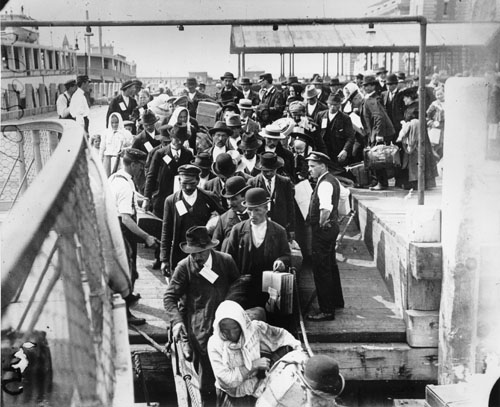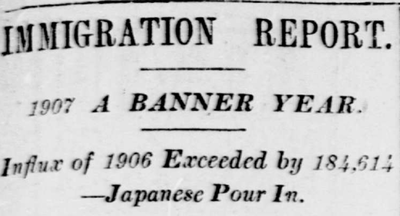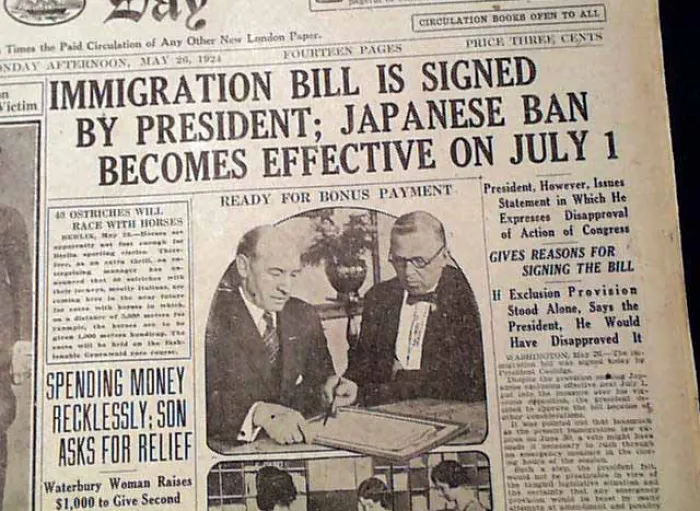Hostility and Myth Building (1875 – 1929)
Following the Civil War, in 1868, the states ratified the 14th Amendment, which enshrined citizenship in the Constitution for “all persons born or naturalized” in the US. The Naturalization Act of 1870 clarified that the new amendment extended a path to citizenship only to “aliens of African nativity and to persons of African descent”. Native Americans and Asian immigrants, in particular, were not included.
Immigration had dropped substantially during the Civil War. As large-scale immigration slowly resumed after the war, several states that had become hostile to immigrant populations began to make their own immigration policies that were designed to discourage immigration. These policies were challenged in court, and in one case in 1876, Chy Lung v. Freeman, the Supreme Court ruled that the power to make immigration policy belonged solely to the federal government. The Chinese Exclusion Act of 1882 was the first legislation in a series of federal responses that codified anti-immigrant sentiment.
Third Immigration Wave
Demographic: Central, Eastern, and Southern Europe (Italy, Poland). Over 20 million immigrants arrived between 1880 and 1920. Many of these immigrants were Catholic or Jewish.
Push/Pull Factors: Loss of agricultural land, loss of markets for artisans, crowded cities, rising taxes, and political and religious repression/ economic opportunities and freedom from persecution.
By 1890, the US had begun to experience a third major wave of immigration that lasted until world war broke out. During this time, over 20 million immigrants, mostly from Central, Eastern, and Southern Europe, came to the US. By 1920, the US had received over 4 million Italian immigrants, about half of whom returned to Italy after about 5 years, and over 2 million Jews from across Eastern Europe who were fleeing religious persecution.
In response to this influx, Congress passed new legislation designed to restore earlier immigration patterns – in other words, to foster a more White population of Anglo-Saxon descent. The new laws capped total annual immigration and imposed numerical quotas based on immigrant nationality that favored Northern and Western European countries. Passage of such laws reflected the era’s xenophobic sentiment, economic fears, and emergent appeal of eugenics.
During this same period, however, the roots of an idealized version of immigration took hold. One of the first expressions of this attitude, a poem penned by Emma Lazarus in 1883 to help raise funds for the Statue of Liberty’s pedestal, includes the now famous lines that were inscribed on the base of the pedestal in 1903:
“Give me your tired, your poor,
Your huddled masses yearning to breathe free,
The wretched refuse of your teeming shore.
Send these, the homeless, tempest-tossed to me,
I lift my lamp beside the golden door!”
Several years later, in 1908, a play entitled “The Melting Pot” opened in Washington, DC. Written by an immigrant from England, it reflected the playwright’s vision of an America that forged a new American identity from the disparate peoples who came to its shores. The play was a success, enjoyed by President Roosevelt and others, and left its mark on our culture as the term “melting pot” became part of the common language to describe the American identity.
As with many national myths, Lazarus’ poem and the “melting pot” possessed sufficient elements of truth to survive, but the reality was less rosy, as the country faced challenges in absorbing so many millions of immigrants in so short a time.
1882

The Chinese Exclusion Act
This law suspended the immigration of Chinese laborers for ten years and made all Chinese immigrants, including scholars and those from other social classes, ineligible for naturalization; this marked the first time immigration in the US was explicitly restricted on the basis of race.
1891

Immigration Act of 1891
This law added immigration restrictions for new groups of people and established the Office of the Superintendent of Immigration under the US Treasury Department. The goal was to expand immigration rules and inspection, as well as to centralize immigration enforcement under the federal government.
1892

The Geary Act and the Opening of Ellis Island
The Geary Act strengthened the Chinese Exclusion Act of 1882 by extending for another ten years the ban on Chinese immigrants becoming citizens. 1892 also marked the opening of Ellis Island, which became the country’s primary immigration station. It processed 12 million immigrants between 1892 and 1954.
1907

The Immigration Act of 1907 and the Gentlemen’s Agreement
The Immigration Act of 1907 expanded restrictions on Asian immigration and created the Dillingham Commision to investigate immigration-related problems and their impact on the nation. The “Gentleman’s Agreement” between the US and Japan ended the immigration of Japanese workers.
1917

The Immigration Act of 1917 (The Asiatic Barred Zone Act)
This law implemented a literacy test intended to reduce European immigration. It also restricted immigration of people from most Asian countries as well as that of homosexuals, criminals, alcoholics, and other categories of “undesirable aliens”.
1924

The National Origins Act (Johnson – Reed Act) and the Establishment of US Border Patrol
The National Origins Act lowered the number of allowable immigrants, making the quota system even more restrictive. In a related move, Congress also established the US Border Patrol to limit illegal crossings on the borders with Mexico and Canada.





